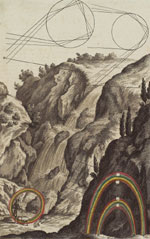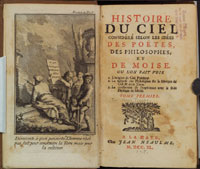Reason and Faith
 Plate from Johann Jakob
Plate from Johann Jakob
Scheuchzer, Physique sacrée
(Amsterdam,
1732–37) –
General Research Division, NYPL
In
the “General Scholium” to the second edition of the Principia, Newton made
a rare public profession of faith, enumerating the power and attributes of
the “Lord God” while affirming that the “most elegant system
of the sun, planets, and comets, could not have arisen without the design and
dominion of an intelligent and powerful being.” Newton’s religiosity
was proverbial. But he was also an anti-Trinitarian heretic, although he took
care (unlike some of his disciples) to conceal his convictions. Also concealed
from public scrutiny were his extensive researches into the prophecies of the
books of Daniel and Revelation, the divinity of Christ, and the history of
the church.
 Noël Antoine Pluche, Histoire du ciel
Noël Antoine Pluche, Histoire du ciel
(The
Hague,
1740) –
General Research
Division, NYPL
Despite
these precautions, Newton’s presumed religious sentiments – based
on his known piety and the few gleanings to be had from the Principia and
the Opticks – offered
a wide scope of action for proponents of a variety of religious (and not so
religious) doctrines. All were eager to co-opt the authority of the great Newton
to enhance their respectability. Newton was thus invoked by English and Continental
Protestants seeking to promote natural theology as well as by those eager to
make him into the patron saint of deism and even materialism. Conversely, orthodox
theologians and laymen of various denominations considered that such malleability
justified their suspicion that Newtonian science could lead to irreligion or
atheism.


